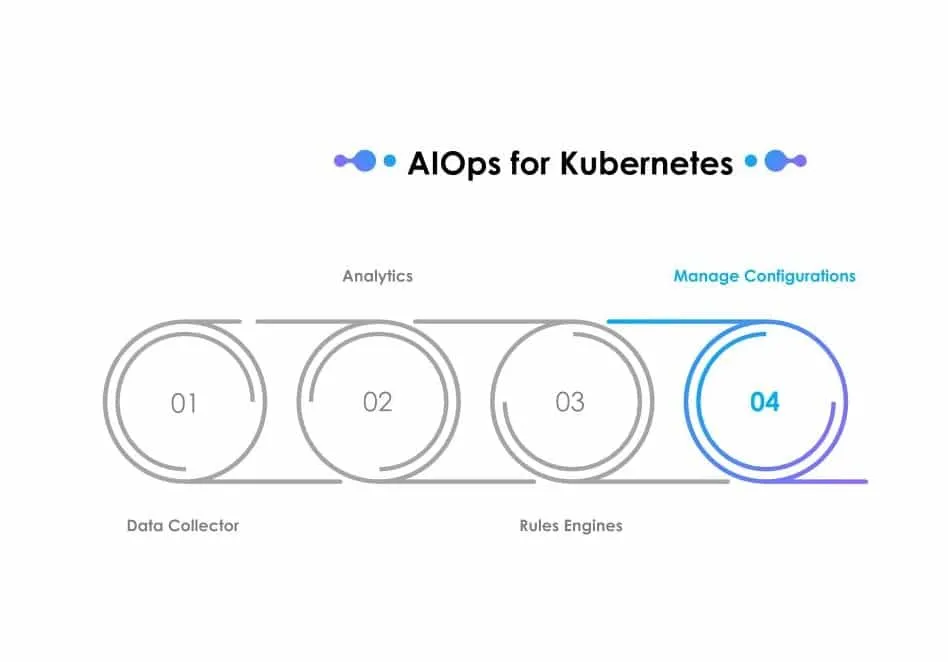Artificial intelligence is no longer in the realm of science fiction. Nor is it limited to hyper-technical fields. 37% of businesses were using some form of artificial intelligence as of 2019.
We have finally reached the tipping point when it comes to artificial intelligence. Deloitte refers to this era as ‘the era of pervasive AI‘. Very soon, there won’t be a single industry that won’t be impacted by artificial intelligence.
Of course, IT is no exception. Let’s take a look at AIOps and how it can be implemented using Kubernetes to help you take advantage of the pervasive AI for yourself!
AIOps For Kubernetes
IT environments can be frustratingly complex. It’s too much for one person, or even a team of IT professionals, to keep up with manually. Some form of machine learning or automation is often necessary to detect anomalies or find opportunities to enhance performance.

Let’s start by looking at the AIOps structure.
1. Data Collector
The first stage of AIOps is data collection. Automation is used to gather information around latency time, CPU load, throughput, and more. This data is then stored in a data warehouse.
2. Analytics
AIOps uses either an ETL or ELT pipeline to consume data from your data warehouse. Then a number of different kinds of analytics can occur. A basic form of analytics is simply a threshold that triggers an alert when surpassed.
More elaborate analytics can take place, as well, using machine learning and automation. This can help detect anomalies, such as data usage at odd times.
3. Rules Engines
Artificial intelligence and machine learning function as a series of decisions. Each decision directs the flow of the AI. You can use the rules engine to differentiate between actions that can be automated and those that require human intervention.
4. Manage Configurations
Artificial intelligence can be set so that harmful configurations can automatically reset harmful software configurations, reboot subsystems, and applications when necessary, and automate other processes to deal with errors when they arise.
Together, these tools give IT professionals the ability to monitor their network no matter their size or complexity. AIOps tools become infinitely flexible and customizable when deployed via Kubernetes, however.
AIOps On Kubernetes
Kubernetes and AIOps are tailor-made for one another. Kubernetes can consist of a large number of containers, at times. This means that it can generate a staggeringly large amount of data, which then needs to be monitored.
This problem becomes self-perpetuating, as well. The larger your Kubernetes server is the more data it generates. This makes it even harder to monitor. Other networks can be comparably large and complex, as well.
Not having an IT monitoring solution in place means that your network could be essentially left unguarded and susceptible to all kinds of difficulties. Considering how costly that downtime can be, at a certain point, AIOps for Kubernetes becomes essential.
Luckily, Kubernetes has many tools and features that make it fairly simple to set up AIOps for Kubernetes.
Tools For AIOps on Kubernetes
In Webhooks mode, Kubernetes performs its own data collection. There are also a number of tools to facilitate data collection, as well. Prometheus is a Kubernetes add-on that collects data as a time series. This data can be visualized with an included dashboard or streamed into another analytics program.
Kubernetes also has built-in analytics tools like metrics-server. This lets you monitor individual containers or applications for unusually high or low usage. There are also add-ons like Jaeger, which can trace an issue back to its source on Kubernetes.
Jaeger can also be integrated with Prometheus to make for an end-to-end monitoring solution.
Kubernetes also has a number of features that can be used to manage your configurations. It can automatically detect corrupted Kubernetes containers, which it then shuts down, quarantines, and then rebuilds.
It’s also got tools for recovering from more severe mishaps. There’s a truly impressive array of tools available for error handling and correction for your AIOps in Kubernetes.
There are even tools for monitoring microservices as part of your AIOps system. Vamp is a platform for automating software releases based using machine learning algorithms. They’ve released a tool known as the Vamp Continuous Cloud Optimizer for monitoring microservices as well as Kubernetes containers.
This is especially essential as Kubernetes can sometimes route resources away from one microservice towards another. This can cause an outage of services or for your applications to under-perform.
Considering how expensive that downtime can be, this is less-than-ideal.
When it’s set up correctly, Kubernetes can become an infinitely expandable monitoring solution for any need. It gives your organization the space to expand and grow, by freeing up your team from having to monitor for errors continually and put out fires when they arise.
Once you get AIOps set up and configured correctly, your organization is set up for absolutely anything. You’ll be set up to be absolutely future-proof, so you can deal with anything as it arises, no matter how unexpected it may be,
Are You Looking To Implement AIOps In Kubernetes?
Artificial intelligence is quickly becoming non-optional. It’s infiltrating every aspect of how we conduct business, from customer service to data visualization. Of course, AI is going to have a particularly profound impact on a technical discipline like IT.
If you’re ready to find out how AIOps for Kubernetes can help your organization be ready for any eventuality, contact us today to set up a consultation!











1 thought on “AIOps for Kubernetes Clusters: The Benefits Explained”
I have many customers interested in AIOps and I feel that your products can match with their needs.